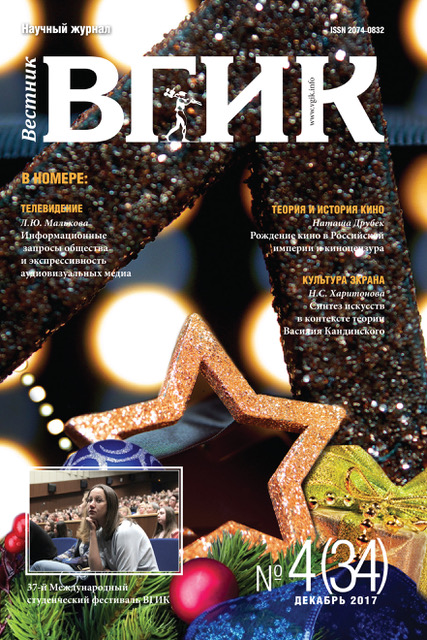The Storming of the Winter Palace as a Mythmaking of National Screen Culture
- Authors: Ilchenko S.N1
-
Affiliations:
- СПбГУ
- Issue: Vol 9, No 4 (2017)
- Pages: 24-36
- Section: FILM LANGUAGE AND TIME | IMAGE GENESIS
- URL: https://journals.eco-vector.com/2074-0832/article/view/14614
- DOI: https://doi.org/10.17816/VGIK9424-36
- ID: 14614
Cite item
Full Text
Abstract
The article analyzes the problems of cinematic authenticity of one of the key events of Russian history of the 20th century - that is the storming of the Winter Palace in Petrograd in autumn 1917. The interpretation of this event of the Great Russian revolution in the author's opinion is a good example to demonstrate the formation of the mythology of the Story, which was one of the meanings of types of screen culture of the Soviet period. The author examines classics of Russian cinema dedicated to the events of 1917 in Petrograd. The study focuses upon three films - October by Sergei Eisenstein (1927), Lenin in October by Michael Romm (1937) and I saw the birth of a new world (2nd part of the novels Red bells, 1982) by Sergei Bondarchuk. Each of the three films is considered as a stage of formation of the image of the fake key events of October 1917. The author reveals the mechanism of formation of the onscreen Canon, which, since the film of Eisenstein, has been perceived as the only possible feature version of the event. Following the task, the author compares subsequent versions of Romm and Bondarchuk's October and concludes that they somehow had at its core thematic and visual concept of an image of the events specified by Eisenstein. The article demonstrates how a combination of different factors, which in the final versions of the films by Eisenstein, Romm, and Bondarchuk has led to the fact that the display concept of the episode "Winter Storm" when in each of them though differed in the details and the circumstances from the origin, coincide in the main idea of the assault on the rebels of the revolutionary masses. Discussing the impact of the three classic films on the related and subsequent films devoted to the events of 1917, the author comes to the conclusion that in the current cinema the visual Canon of interpretation has a strong mythological style, which is at odds with the facts of documentary evidence and confirmation, which are in opposition to the established due to the cinema version. This allows to identify the on-screen episodes analyzed as a complex historical fake, which has obtained a pseudo-real life on screen.
About the authors
Sergey N Ilchenko
СПбГУ
Author for correspondence.
Email: editor@vestnik-vgik.com
Doctor of Philology, Associate Professor. Higher School of Journalism and Mass Communication, Saint Petersburg State University, editor-in-chief, “Kulturny Petersburg” paper, author, presenter and reviewer of the “Petersburg” radio station.
References
- Бондарчук С., Прянишников А. Восстание. - М.: ВОАП-ИНФОРМ, 1985. - 95 с.
- Высторбец А.И. Сергей Бондарчук. Судьба и фильмы. - М.: Искусство, 1991. - 333 с.
- Данилкин Л.А. Ленин. Пантократор солнечных пылинок / Лев Данилкин. - М.: Молодая гвардия, 2017. - 783 с.
- Зак М.Е. Михаил Ромм и традиции советской кинорежиссуры. - М.: Искусство, 1974. - 280 с.
- Логинов В.Т. Ленин в 1917 году. На грани возможного / Владлен Логинов. - Москва: Алгоритм, 2016. - 576 с.
- Петербург как кино. - СПб.: Мастерская Сеанс, 2011. - 392 с.
- Рид Джон. 10 дней, которые потрясли мир. - М.: Государственное издательство политической литературы, 1959. - 352 с.
- Ромм М.И. Как в кино. Дубль-2. Устные рассказы. - Нижний Новгород: ДЕКОМ, 2014. - 304 с.
- Шкловский В.Б. Эйзенштейн; 2-е изд. - М.: Искусство, 1976. - 296 с.
- Эйзенштейн С.М. Избранные произведения в 6-ти томах. Т. 6. - М.: Искусство, 1971. - 559 с.
Supplementary files








